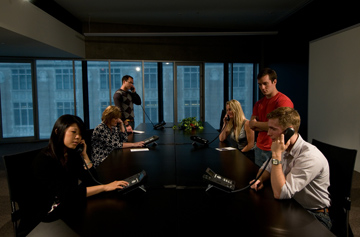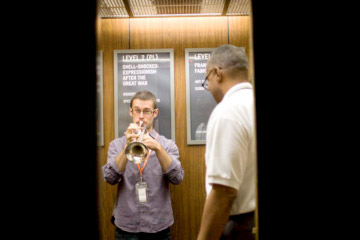
Carey Young, "Speech Acts," 2009. Installation view at Contemporary Art Museum St Louis. Photo: David Ulmer.
In 1974, Hans Haacke mounted an index of the museum’s corporate sponsors and board of trustees along the Guggenheim’s walls. The work, simply titled, Solomon R. Guggenheim Museum Board of Trustees, bared the political and economic affiliations behind the exhibition’s proverbial curtain. For Haacke, the work’s site (the museum) became the “institutional membrane” linking artistic avant-garde practice to global corporate and political networks — as it was for many of his earlier air flows and condensation cubes — by way of the cultural negotiations between exhibition sponsorship and museum board membership. And, as Benjamin Buchloh of October wrote, such work “turned [the self-reflexivity of conceptual practice] back onto the ideological apparatus itself, using it to analyze and expose social institutions from which the laws of positivist instrumentality and the logic of administration emanate in the first place.” For Haacke, as for other conceptual practitioners such as Marcel Broodthaers, the late sixties and seventies were a critical period for revealing the entangled relationships between cultural production and the corporate institution — be it the Guggenheim Museum or Philip Morris, official sponsor of the seminal 1969 exhibition, When Attitudes Become Form. Yet, as much of this work was situated within the museum itself, these radical conceptual strategies were quickly subsumed under their own “institutionalization.” Today, this kind of Marxist materialist analysis that compelled Haacke to disturb the commodity system of art production seems to have been extinguished.
There was a moment when institutional critique held some currency as a proposition for (and often against) the ethical standards of arts institutions. But is this brand of critique a viable, or even a compelling, possibility for art practice today? It’s nothing new to say this genre of conceptual art—in its dematerialized, utopian resistance to market forces and the corporate institution—had long ago foreclosed on its own radical potential. As Ian Burn, for one, recalled in hindsight, “Such intellectual Luddism was unashamedly idealistic… perhaps the most significant thing that can be said to the credit of conceptual art is that it failed.” Despite intention for revolution, as Burn suggests, the contentious history of institutional critique was troubled early on by the avant garde’s inevitable, and ineluctable, affiliation with economy. Its pursuit of criticality, in other words, was largely quashed by its failure to produce more than merely revelatory gestures.
And, until recently, largely neglected in scholarship was the fact that conceptual art was marketed as commodity from the moment of inception. In 1967, Seth Siegelaub—an art dealer famous for branding and first promoting the neo-avant garde in New York—drafted a brochure to prospective corporate collectors. In it, he advertised the “marketability”—the use-value—of the corporate world’s partnership with culture. Siegelaub’s advertising prospectus would hardly be shocking today. Indeed, corporate sponsorship has become de rigueur in the new millennium, and increasingly, images of radicality and revolution—now often perceived as impotent gestures—are marshaled by global brands and marketed back to us as exchangeable commodities. All told, the great weakness of institutional critique (as shaped by Haacke, Fraser, Wilson, Asher, and others) as an alternative model for production was its failure to move beyond the exposure of unethical (or questionable) institutional practices in favor of effecting real change. Artist-activists certainly took up this mantle a decade later, as did a generation of artists who began to move beyond the museum frame to explore other sites of information.

A Machine Project Field Guide to LACMA: Musical Elevators by Various Artists. Photo courtesy of Machine Project.
Today, the productive alternatives to this troubled life of institutional critique lie with those artists who pose not critiques but insertions within our institutional frameworks. British artist Carey Young, for one, positions herself as an inheritor of the legacy. And yet her practice, characterized by its investigations of the corporate and legal worlds from an insider perspective, actively resists these historical models of critique. In a 2009 exhibition at the Contemporary Art Museum St. Louis, Young collaborated with a communications company headquartered in St. Louis and employing its tools, software and live agents, launched a series of specially-adapted call center services. Extending the visitors’ experience beyond the walls of the museum into the telephonic, hypertextual labyrinths we explore by phone, Young juxtaposed the Contemporary’s architecture with the negative spaces, and the administrative networks, of the institution. While nodding to works by Robert Morris, Cildo Meireles, and even Andrea Fraser, Young’s exhibition, at its core, explored the conditions of site-specificity, language, performance, and our own capacity to communicate in the world by activating her audience as both agents and performers.
Some young notable artists, such as AGENCY (initiated by Brussels artist Kobe Matthys), and Danish duo Nina Beier & Marie Lund, explore institutional memory and the history of objects, loosely tying their practices to a teleology of institutional critique. But again, how do we as an audience register, and participate in, the exploration of institutional site? In Los Angeles, the small storefront Machine Project offers an extraordinary example of “ideological insertion.” A performance and installation space that investigates art, technology, natural history, science, music, literature, and food, Machine’s enterprise relies on “hands-on engagement” to make rarefied knowledge accessible. Recently, the Hammer in Los Angeles invited Machine to create a new kind of interactive museum, and last November, Machine was invited to visit the Los Angeles County Museum of Art, “orchestrating ten hours of performances, workshops, and events experimenting with LACMA’s expansive grounds and enormous collection of stuff.” If the practice of institutional critique reflected critically on its own place within galleries and museums and on the concept and social function of art itself, Machine has leapt into this territory, but, instead of merely unmasking the “institutional membrane,” invites us to experience the institution anew.
Laura Fried is Assistant Curator at the Contemporary Art Museum St. Louis.



Pingback: Barely peripherally related blogaround – Art, Ethics, shared space, shared culture « words on art
Pingback: Brenna Maag « Anastasia E White
Pingback: From Institutional Critique to Institutional Insertion | The Hyrtl Simulacrum
Pingback: forever and a day